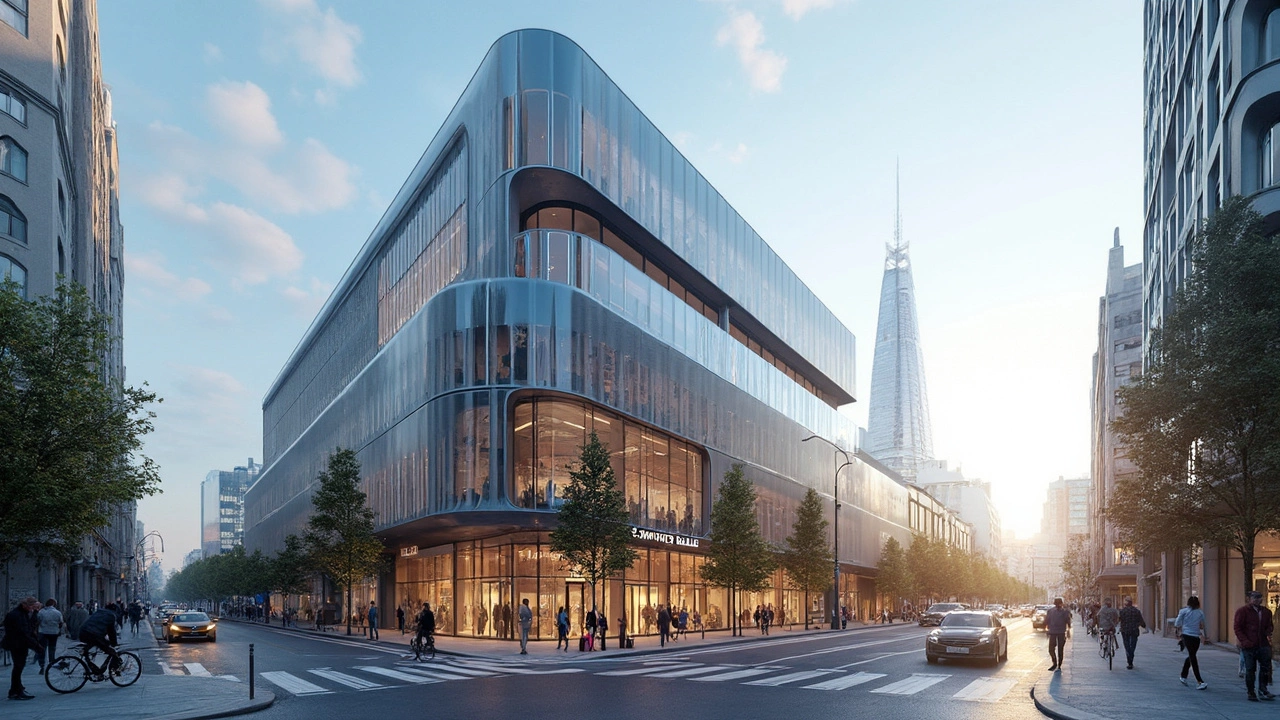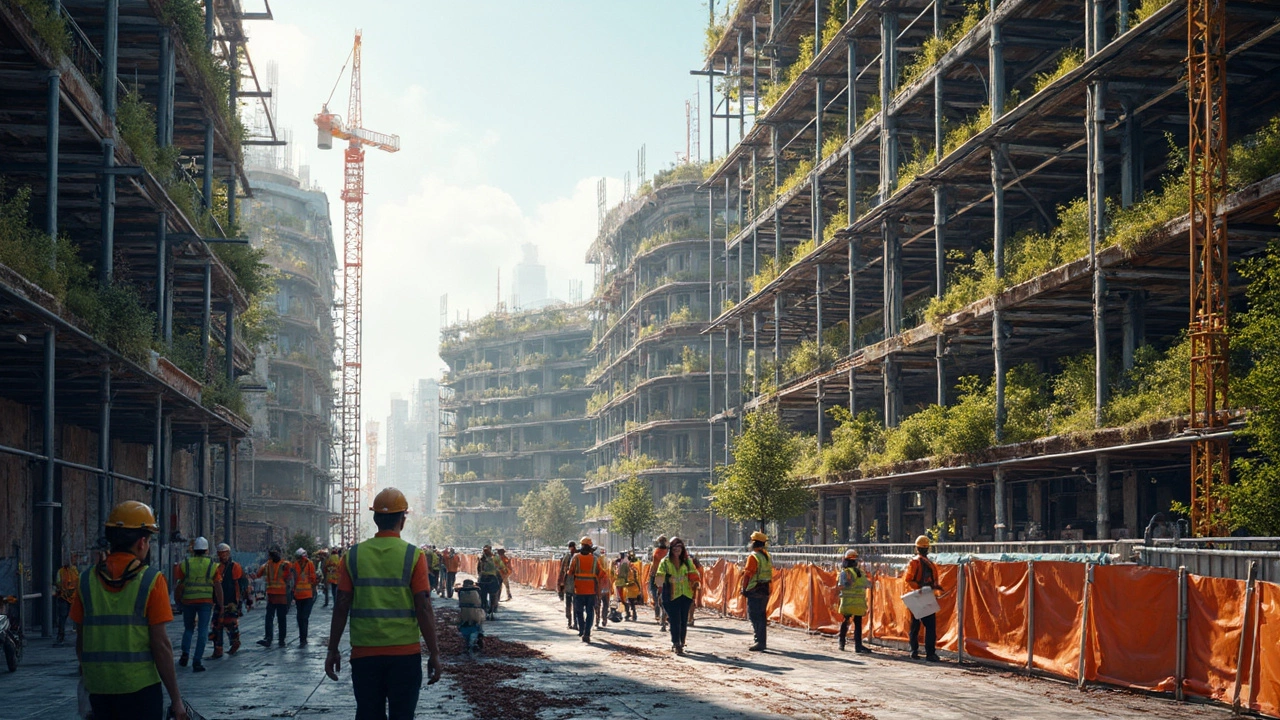Commercial construction isn't just putting together bricks and steel beams; it's about making strategic decisions to ensure your building is both functional and cost-effective. The type of construction you choose can impact everything from your budget to the overall vibe of your space. Steel structures are classics in the industry for their durability and strength. They're like the reliable workhorse of construction materials—great for large spans and high-rise buildings where you need robust support.
Then there's concrete, which isn't just about durability; it's about adaptability too. You can shape it, mold it, and make it meet your vision, all while keeping in mind the long-term benefits like insulation and fire resistance. For those looking at a quicker turnaround, modular buildings might catch your interest. They're speedily constructed off-site and then pieced together like a giant Lego set. Talk about efficiency!
- Understanding Steel Structures
- Benefits of Concrete Construction
- Exploring Modular Buildings
- Embracing Eco-Friendly Materials
- Choosing the Right Type for Your Needs
Understanding Steel Structures
When it comes to commercial construction, steel structures are often the go-to choice for many builders and architects. And there's a good reason why. Steel is like the backbone of high-rise buildings and vast spaces. It's known for its strength, flexibility, and durability, making it a favorite in the construction world, especially for commercial projects like warehouses, factories, and multi-story buildings.
One of the standout features of steel is its ability to withstand external pressures—think heavy winds, earthquakes, and weight loads. Plus, it's lightweight compared to other construction materials, helping you save on foundation expenses. More strength for less weight—it’s a combo that’s hard to beat.
Beyond the brawn, steel is also a friend to the environment. It's 100% recyclable, meaning once its building life is over, it can be transformed into new materials without losing its properties. It's like giving a steel beam a second life!
Let's not forget the speed of construction. With prefabricated steel components, you cut down on construction time significantly. This means your project goes up faster, reaching the finish line ahead of schedule. Who doesn't love a quicker turnaround?
| Property | Details |
|---|---|
| Recyclability | 100% |
| Strength-to-Weight Ratio | High |
| Construction Speed | Fast |
When budgeting, keep in mind the initial cost; steel might seem pricey upfront but considering its long lifespan and low maintenance needs, it balances out in the long run. Choosing steel for your building types can save money on repairs and replacements down the road. Whether you're setting up shop in a single-story retail space or reaching for the skies with a skyscraper, steel's robustness and versatility make it a solid choice.
Benefits of Concrete Construction
When it comes to picking materials for commercial construction, concrete's often the go-to choice—and for good reasons. This stuff isn't just a rock-hard option (pun intended); it's versatile and can take on various forms and finishes that suit your project's needs.
First up, durability. Concrete is like the Hercules of building materials. Once it's set, it's tough and can withstand heavy loads, making it ideal for structures that handle a lot of foot traffic or industrial-grade activity. You won't be worrying about cracks or wear and tear as much as you would with some other materials.
Another perk is its outstanding fire resistance. Concrete won’t go up in flames, which means it’s safer and might even save you a bit on insurance. Plus, it acts as a great insulator—keeping your interiors cool in the summer and warm in the winter without needing to overwork the HVAC system.
Let's not forget cost-effectiveness. While the upfront might seem a bit steep, in the long run, you're saving on maintenance and energy bills. Plus, concrete’s ability to be molded into creative shapes and finishes gives architects the freedom to design unique aesthetics without going overboard on costs.
Looking at lifecycle impact? Concrete's relatively eco-friendly when you consider it can be made from local materials, reducing the carbon footprint of transportation. And when its life in your building is over, many aspects of it can be recycled and reused.
| Feature | Concrete |
|---|---|
| Durability | High |
| Fire Resistance | Excellent |
| Cost | Moderate |
| Insulation | Good |
Choosing concrete can be an all-around smart decision for those who want a balance of durability, safety, budget considerations, and a nod towards sustainability. As you plan your commercial structure, keep concrete in the discussion—you might find it's just what your project needs.

Exploring Modular Buildings
Modular buildings are shaking up the commercial construction scene. They're like the fast-food version of building—quick, efficient, yet packed with the essentials. The magic happens off-site, where sections are crafted in controlled environments, and then they're transported to the location for assembly. This means less chaos on-site and a timeline that's often significantly shorter compared to traditional building methods.
One of the coolest things about modular construction is its versatility. You're not boxed into a specific design just because it's modular. Whether you want sleek and modern or cozy and traditional, there's a module for that. Plus, it’s super easy to expand in the future. Need more space as your business grows? Just add more modules.
Cost efficiency is another big win. By controlling the environment during production, waste is minimized, and labor costs are typically lower. It's like hitting the jackpot when trying to stay within budget. And let’s not forget about sustainability. Many modular buildings use eco-friendly materials, making them a smart choice for businesses looking to go green.
Check this out:
| Advantage | Details |
|---|---|
| Speed | Faster completion time due to simultaneous site and building work. |
| Cost-Effective | Reduces waste and often comes with lower labor costs. |
| Flexibility | Easy to expand or modify. |
| Sustainability | Incorporates eco-friendly building materials. |
So, if you're pondering the next move for your commercial space, consider modular construction. It aligns with today's fast-paced demands without compromising on quality or style.
Embracing Eco-Friendly Materials
Going green isn't just a trend; it's a smart, financially rewarding decision in commercial construction. Eco-friendly materials tick all the boxes—they're good for the environment, often more cost-effective over time, and they appeal to today's eco-conscious clients.
First up, consider using recycled materials. Things like reclaimed wood or recycled steel not only cut down on new material costs but also lend a unique, character-filled look to the building. They're a win-win for sustainability and style.
As for insulation, sheep’s wool and recycled denim (yes, your old jeans) are great eco-friendly options. They're effective at keeping temperatures stable, reducing the energy needed for heating and cooling. Not only does this cut costs, but it also makes for a more comfortable space.
Then there's bamboo, a superstar in sustainable building. Known for its rapid growth rate and hardy nature, bamboo is an excellent choice for flooring and cabinetry. Plus, it brings a warm, natural feel to interiors.
If you want to dive deeper into green tech, consider solar panels for electricity. They might seem pricey upfront, but they pay back in energy savings. Check out this basic comparison of payback periods for solar investments across different climates:
| Climate | Payback Period (Years) |
|---|---|
| Sunny (e.g., Arizona) | 5-7 |
| Moderate (e.g., North Carolina) | 7-10 |
| Lesser Sun (e.g., Seattle) | 10-15 |
Ultimately, embracing eco-friendly construction materials doesn't just save you money; it's about positioning your building—and your business—as forward-thinking and responsible. That's something clients love to see.

Choosing the Right Type for Your Needs
So, you're gearing up to build a commercial structure, but which type of construction suits your needs best? It all boils down to your specific requirements, budget, and timeline. The good news is, there’s no one-size-fits-all. Here's the lowdown to help you choose wisely.
The first thing to consider is what your building will be used for. A restaurant might benefit from a modular building approach because of its speed and cost-effectiveness. Meanwhile, a high-rise office could lean towards steel’s strength for those towering heights. Essentially, form follows function. As Henry Louis Gates Jr. puts it,
"Each type of construction has its unique strengths that mesh with different goals."
Your budget plays a huge role too. Steel might cost more upfront, but it can save you money in maintenance. On the flip side, concrete is versatile—great for different designs and budgets. And for those trying to keep things green? Opt for eco-friendly materials, which are kind on the environment and can also be solid for long-term savings.
- Ask yourself what matters most: speed, strength, or sustainability?
- Consider future maintenance costs alongside initial expenses.
- Think about the image you want your building to project.
And let's not forget the timeline. If you're in a rush, modular might just be the hero of your story since it can significantly cut down construction time. According to a recent report by the Modular Building Institute, construction timelines can be reduced by up to 50%! This could mean getting your business up and running quicker than expected.
| Building Type | Estimated Construction Time | Average Cost |
|---|---|---|
| Steel | 12-24 months | High |
| Concrete | 9-18 months | Medium to High |
| Modular | 3-6 months | Medium |
| Eco-Friendly | Varies | Varies |
Decision-making in the world of commercial construction can feel overwhelming, but breakdown each factor step by step, and soon enough, you'll have a clear path forward. Remember, it's all about finding the balance that works for you.

Author
Damon Blackwood
I'm a seasoned consultant in the services industry, focusing primarily on project management and operational efficiency. I have a passion for writing about construction trends, exploring innovative techniques, and the impact of technology on traditional building practices. My work involves collaborating with construction firms to optimize their operations, ensuring they meet the industry's evolving demands. Through my writing, I aim to educate and inspire professionals in the construction field, sharing valuable insights and practical advice to enhance their projects.